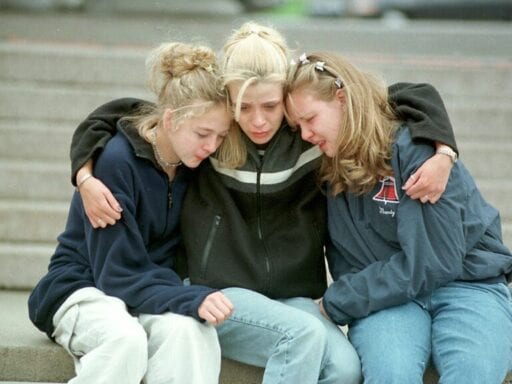The US still has a gun violence problem.
Today marks the 20th anniversary of the Columbine High School shooting, in which two students killed 13 people and themselves on April 20, 1999. But the US has not solved its mass shooting problem in those 20 years — the country now averages nearly one mass shooting a day, based on one group’s definition of mass shooting.
We don’t have good data going back to the Columbine massacre. But we do have data going back to another school shooting, at Sandy Hook Elementary School in Newtown, Connecticut, on December 14, 2012.
Since the Sandy Hook shooting, there have been more than 2,000 mass shootings in which four or more people, excluding the shooter, were shot but not necessarily killed. Nearly 2,300 people have been killed and almost 8,400 have been wounded.
Since 2013, there has been only one full calendar week — the week of January 5, 2014 — without a mass shooting.
Here’s how all of those shootings since Sandy Hook look in map form, based on data from the Gun Violence Archive and taken from the Vox tracker developed by Kavya Sukumar:
/cdn.vox-cdn.com/uploads/chorus_asset/file/16179263/mass_shooting_map.jpg)
A number of particularly deadly mass shootings stand out on that map.
In Las Vegas in October 2017, a gunman killed 58 people and wounded hundreds more. In June 2016, a gunman in Orlando, Florida, killed 49 people and wounded dozens more at a gay nightclub.
And in Parkland, Florida, a gunman killed 17 people and wounded 17 others at Marjory Stoneman Douglas High School in February 2018. That shooting inspired a new national movement for gun control, culminating in the March for Our Lives in Washington, DC, and sister marches across the country in March 2018.
Not every state has been affected equally. Here’s a map of the number of mass shootings since Sandy Hook, after controlling for population, in each state:
/cdn.vox-cdn.com/uploads/chorus_asset/file/16179264/mass_shooting_map_by_state.jpg)
Since around 2015, the number of mass shootings has averaged around one a day.
These calendars display casualties from mass shootings since 2013, the year after the Sandy Hook shooting:
/cdn.vox-cdn.com/uploads/chorus_asset/file/13756979/mass_shootings_calendar_2013.png)
/cdn.vox-cdn.com/uploads/chorus_asset/file/13756981/mass_shootings_calendar_2014.png)
/cdn.vox-cdn.com/uploads/chorus_asset/file/13756982/mass_shootings_calendar_2015.png)
/cdn.vox-cdn.com/uploads/chorus_asset/file/13756983/mass_shootings_calendar_2016.png)
/cdn.vox-cdn.com/uploads/chorus_asset/file/13756985/mass_shootings_calendar_2017.png)
/cdn.vox-cdn.com/uploads/chorus_asset/file/13756986/mass_shootings_calendar_2018.png)
So far in 2019, 115 people have been killed and 318 have been wounded in 91 mass shootings over 109 days — again, nearly one mass shooting per day.
/cdn.vox-cdn.com/uploads/chorus_asset/file/16179265/mass_shooting_calendar.jpg)
The data in these maps and calendars is based on the Gun Violence Archive’s count, which defines mass shootings as events in which four or more people, excluding the shooter, were shot, but not necessarily killed, at the same general time and location. That definition differs from others, which may require that four or more people are killed, or which may exclude certain shootings, such as gang-related and domestic violence events.
America is a big outlier among developed countries when it comes to gun deaths, in large part because the country has so many guns, making it easy to carry out an act of violence. Studies have linked stricter gun laws to fewer gun deaths. But the US has the weakest gun laws in the developed world.
/cdn.vox-cdn.com/uploads/chorus_asset/file/13757408/mass_shootings_chart_01.png)
As shocking as mass shootings are, they are responsible for only a small portion of all gun deaths in the US. In 2016, according to the Centers for Disease Control and Prevention, 39,000 people died of gun-related injuries. Mass shooting deaths represented less than 2 percent of all gun deaths in the US that year — 451 of nearly 39,000 overall gun deaths.
This chart shows mass shooting deaths and overall gun deaths, with each block representing 10 gun-related deaths:
/cdn.vox-cdn.com/uploads/chorus_asset/file/16177397/mass_shootings_chart_02.jpg)
Meanwhile, more than 14,000 of the gun deaths that year were homicides, and almost 23,000 — the great majority — were suicides.
/cdn.vox-cdn.com/uploads/chorus_asset/file/13757414/mass_shootings_chart_03.png)
The evidence suggests that curtailing access to guns would not only prevent some mass shootings, but also help curtail other gun deaths, including homicides, suicides, and accidental shootings. Until America confronts that problem, it will continue to see levels of gun violence far outside the norm among other developed nations, just as we’ve seen after Columbine, Sandy Hook, and Parkland.
For an interactive version of these maps and the other charts in this article, check out Vox’s full story. And for more on America’s gun problem in general, read Vox’s explainer on the issue.
Author: German Lopez
Read More



